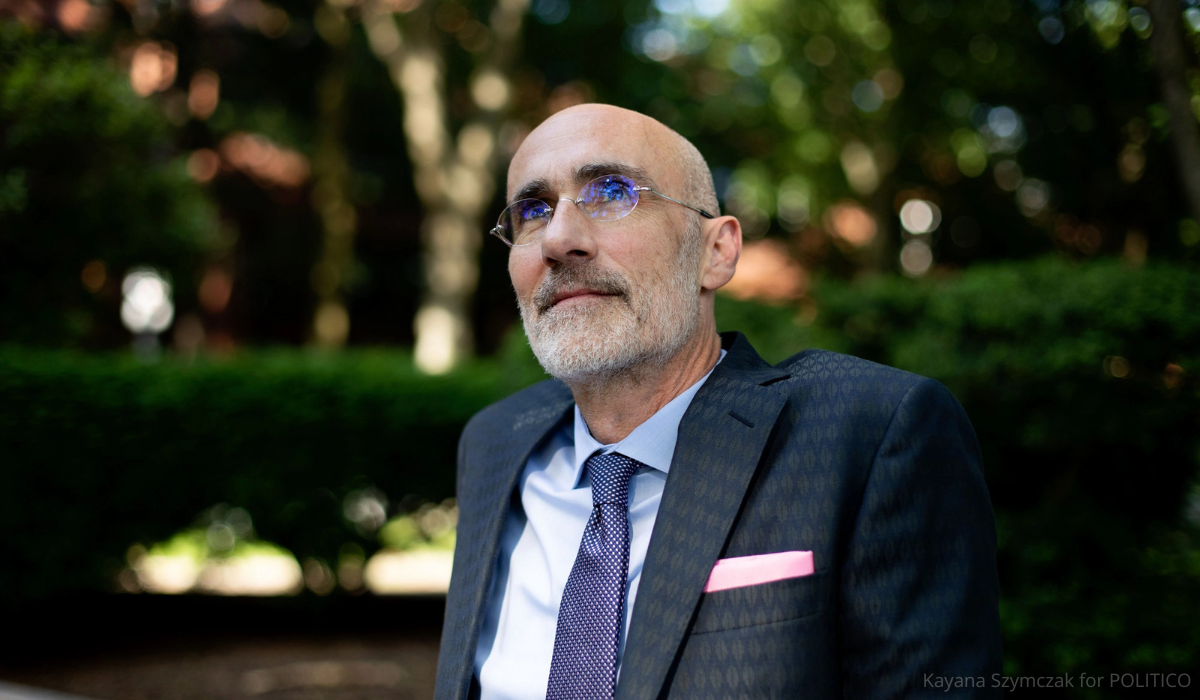Arthur C. Brooks Has the Secret to More Joy

It's a hurdle so ubiquitous, there's a hit song about it: the fact that we can never get enough satisfaction. Or make that, lasting satisfaction. We want newer cars and bigger houses. We yearn for the buzz felt from reaching a goal to linger forever, and when it doesn't, we seek more, always hoping to achieve and sustain the joy we envision.
Psychologists give this never-ending pursuit a name: the hedonic treadmill. No matter how quickly and endlessly we row toward goals and more things, we can never seem to dock the boat at the island of joy and enduring satisfaction. We get the buzz of achievement, then we're on to the next thing.
This dogged quest doesn't mean something is wrong with us. Quite the contrary, says Arthur C. Brooks. Human beings "are goal-oriented creatures," which is why we seek to make forward progress, the social scientist tells us. "We want the satisfaction of attaining the goal." So, then, what gets in the way of the enduring happiness part? Well, the answer is both fascinating and optimistic. As Brooks shows us, we can beat the curse of dissatisfaction—and in doing so, we open our world to more joy and freedom.
First, Why Do We Always Want More? A 101
Simply put: We conclude the wrong thing, says Brooks. To understand this, he offers a 101 on how our emotions function. Good and bad, emotions are not meant to last. "Emotions are supposed to come and go because they're nothing more than signals from our brains to say that something is an opportunity or a threat," explains Brooks. When something poses a threat, such as an animal sneaking up on us, we experience a negative emotion, like fear or anger. On the contrary, when we encounter something opportune or beneficial, we react with feelings that prompt us to approach it, such as joy. But all of these feelings are fleeting because we're designed to always act appropriately to the next set of circumstances, says Brooks."That's what emotions are for: to help you survive and pass on your genes. They’re not there to give you a good day or so that you can sit there glowing about the big break in your career for the next 10 years."
But here's the issue: We think, or at last want, that good feeling to last. So, when we make that major milestone or obtain a new shiny thing, we get the good feeling of satisfaction, and then it goes away. Our response is then, So I guess I need more! "You conclude exactly the wrong thing, which is that the right solution to get emotions that persist is for you to have more and then more and then more," says Brooks. Enter again, the hedonic treadmill. Meanwhile, your emotional system is naturally resetting, a process known as homeostasis. "This is going back and forth and back and forth. And people keep running and running and running with dissatisfaction for their whole lives," he adds.
The Issue Is Human, Global, and Timeless
It's easy to blame our lack of satisfaction on modern American life. After all, the endless messages spewing from social media, TV, and every corner of contemporary society say we need bigger, better, brighter things to be happy—right? However, Brooks calls bluff on this. Humans have wrestled with never feeling satisfied enough forever. "We have a tendency in the United States to think that if you go to some indigenous culture somewhere, they're living in peace and harmony without goals," he says. "No. They want more animal skin. They want more buffalo jerky for the winter. And so did your ancestors 250,000 years ago."
The manifestation of the desires, however, has evolved, and that depends on the cultural context and current economy. So right now, the "more and more" might mean getting a Ferrari, a bigger house, or famous. But 250,000 years ago, it might have meant getting a bigger cave, says Brooks. "It's all the same impulse, because that's how the human brain is wired."
There Is Good News: We Can Outsmart This Impulse
Human beings are brilliant machines. One reason is because we have a prefrontal cortex, "a huge bumper of tissue behind your forehead" that makes up 30 percent of your brain by weight, says Brooks. The prefrontal cortex allows us to make decisions, plan, control impulses, regulate our behavior, and more. "It’s a supercomputer," adds Brooks. "The result of that is that we can do all sorts of marvelous things." Unlike dogs or any other animal, we can have control over our impulses and desires.
"We think of human beings as being part animal and part divine," adds Brooks. "Your animal nature is giving in to your impulses, and your divine nature is living up to your moral aspirations. It is standing up to your nature and your impulses with the person you want to be, as opposed to the person you feel you are."
A Practical Suggestion for Outsmarting Dissatisfaction and Gaining More Joy
"Satisfaction, in the ancient impulse realm, means having everything you want and having more of it, and that leads you to be on the hedonic treadmill and run and run and run toward more things and audacious goals," says Brooks. However, this mindset of more-more-more is the wrong way to think about it all. The right way to think about it is: lasting satisfaction equals what you have divided by what you want. "It has two levers on it: halves divided by wants," says Brooks.
While our biological imperatives tell us to focus on increasing the numerator, aka our haves, the life-changing shift happens in the denominator, aka wants. When your denominator falls, your satisfaction will rise, says Brooks. "That’s more efficient mathematically, and it's more enduring psychologically. If you can become the master of wanting less, your satisfaction will hang around." Brooks calls this a "wants management strategy" versus just a "have more strategy." The wants management strategy is necessary—and a critical key to having more joy, satisfaction, and happiness in life.
Defining Wants Versus True Needs
We’ve convinced ourselves that things we merely want are needs, says Brooks. Differentiating these might be tricky, which is why is says we must look within and ask: Are these my nutritional needs? Are these my shelter needs? Are these the needs I have for love in my life? Or are these just wants?
Brooks suggests categorizing "wants" into two categories: wants that are not genuine needs versus wants that are real needs. The wants that are not real needs can be classified as money, power, pleasure, and the admiration of others. Brooks calls these big four the "idol" wants.
On the other hand, there are the true needs that fulfill a life, which fall into the categories of faith, family, friendship, and work that serves others. "Those are the wants that are meritorious," adds Brooks. "But you can't even see them if you’re being blinded by the first four. The first four wants are idols. The last four wants are divine."
Arthur C. Brooks, PhD is a contributing writer at The Atlantic, host of the How to Build a Happy Life podcast, and a professor at the Harvard Kennedy School and the Harvard Business School. He is the author of 13 books; his newest is the forthcoming The Happiness Files: Insights on Work and Life.
Please note that we may receive affiliate commissions from the sales of linked products.




